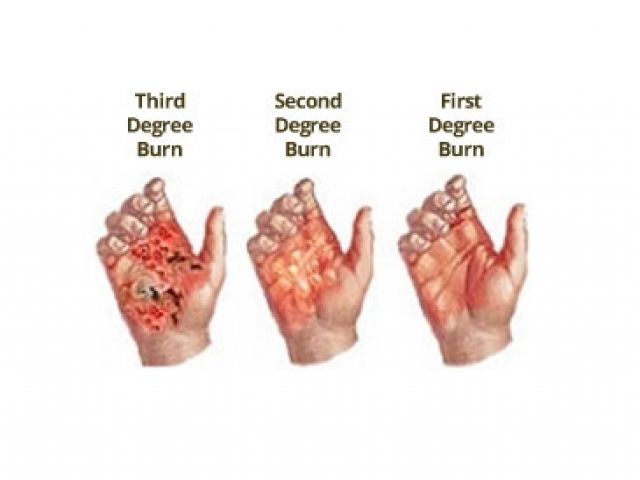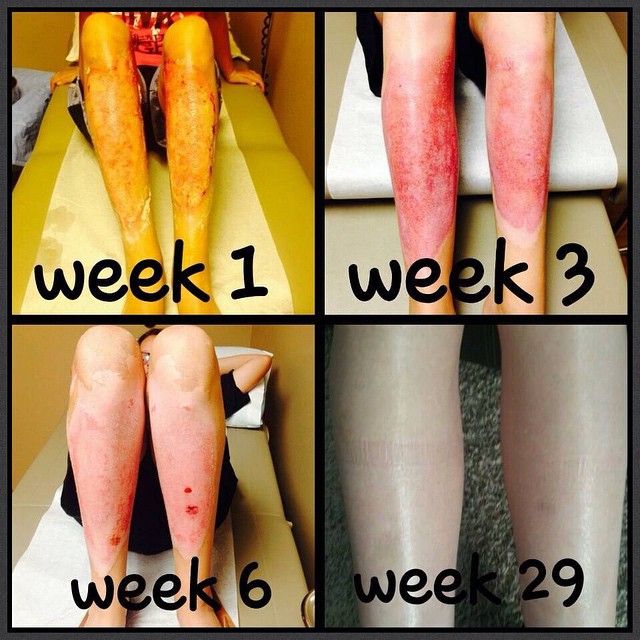2nd vs 3rd degree burn
Keeping the area away from the air by using bandages. First degree burns are less severe than second degree burns and typically do not require medical treatment.
 |
| First Second And Third Degree Burns Degree Burns Burns Burns Treatment |
They may appear deep red and swollen and may look wet and shiny when the blisters break.

. With second-degree burns there is risk of secondary infection and scarring especially with a deeper second. They are also known as full-thickness burns as they completely damage both the outer and the inner layer of the skin. What to do about third degree burns. In addition to the blisters these burns are more painful and more worrisome.
Briefly touching a hot pot for example would give you a first degree burn. Third-degree burns can give the skin a white or black look and skin may become numb. Third-degree burns often destroy pain-sensing nerves in the lower layers of skin which means they may not hurt very much. Burns are classified into first second and third degree burns.
3rd degree burns hurt around the fringes or outlines where its still only 2nd-1st degree. The body just kind of generalizes it. Third-degree burn - Also known as full thickness burns - eschar formation is present in these burns45. Since third-degree burns destroy nerve endings they are not painful.
Treatment for second degree burns may include. They affect both the epidermis. Second-degree burns affect the outer layer of skin and the layer beneath. There should be no raised scar.
The burn site appears red blistered and may be swollen and painful. Second degree burns are moist and red. Refraining from popping blisters to avoid infection. Third-degree burns are considered a medical emergency and should be treated by a doctor.
4Third-degree burns are the most serious deepest type of burn that heal in the longest time. These burns only affect the outer layer of your skin. Second-degree deep -eschar formation is seen as it involves deep reticular dermis. Ad Wide Range Of Products To Cure Wounds.
Second degree burns do require medical attention especially if they cover a large area. 3They usually need at least one month to completely heal. Second degree burns are severe than the first degree burns. Blisters are frequently present and they are often very painful.
Severe second-degree burns extend deeply into the dermis but never reach the underlying fatty tissue. One Stop Shop For All Wound Care Products Avail From Top Selling Brands Ships Fast. These burns cause no or little pain due to the damage caused in the nerves. It typically takes two to three weeks or more for a second-degree burn to heal and the skin may become lighter or darker.
The wound may ooze or bleed. Burns are classified according to the depth of injury caused to the dermis. Do not touch the wound. Third Degree Burns are the.
And if youre in that much pain youre not really gonna notice that the center area is not as painful. The mildest being the 1st degree burn and the worst being the 4th degree burn. Skin grafting in severe cases. These burns are very painful due to the fact that nerve endings are intact but are exposed due to loss of the epidermis.
Third-degree burns also called full thickness burns are more severe than second-degree burns. They may also be susceptible to infection especially when the blisters break. You can have a first- second- third- or fourth-degree burn. This causes pain swelling and blistering.
The higher the degree the more severe the burn is. Third-degree burns destroy all the tissue of the epidermis and dermis and they extend into the fatty tissue below the dermis. They exhibit the characteristics like skin with swelling and blister formation. Healing can require up to eight weeks and scarring may occur.
The burned area turns red and is a little irritated but. Scarring may result but is generally minimal. It will feel less painful than a second-degree burn ironic I know and the appearance of the skin will be leatherwaxy in nature. The nerves of 3rd degree areas are dead though.
Second-degree superficial where vesication and inflammation is seen in skin as only papillary dermis is involved. 1st degree burns is when only the outer layers or the superficial layers of your skin is burned. Third-degree burns need emergency medical care. The following write-up provides information on the symptoms and treatment of such injuries.
Third-degree burns cause severe damage to the skin. Most second degree burns can be treated as minor burns if the burn area is no more than 2-3 inches but seek medical help if you feel your burn is severe. Burn injuries are mainly classified into 1st 2nd and 3rd degree burns. The second degree burns form scarring unless properly removed and the third degree requires a skin graft.
When the injury extends into some of the underlying skin layer it is a partial-thickness or second-degree burn. A third degree burn is the worst among them. Right off the bat the skin will never heal without a skin graft. You can make it worse by doing so.
Second degree burns are also called partial thickness burns. A burn is a type of skin injury that occurs due to contact with chemicals radiation intense heat or electricity. Third-degree and fourth-degree burns may need more intensive treatments such as. Second-degree -partial thickness burns Second-degree burns involve the epidermis and part of the dermis layer of skin.
Pain may last for two or three days and then subside. Superficial partial-thickness burns normally heal in approximately two weeks. However they often have second-degree burns around them. Second-degree burns usually heal within two to three weeks.
In a full-thickness or third-degree burn the injury extends to all layers of the skin. Third-degree burns or full thickness burns destroy all of the epidermis and dermis. Visibly the skin itself will be black brown or white. There may be blister formation.
Second-degree burns are painful and usually blister. 2Second-degree burns affect the epidermis and the dermis layers of the skin which are characterized by blistering. Second-degree burns also called partial-thickness burns affect the outermost layer of skin and extend to the middle skin layer below. I cannot emphasize how much.
To say that 3rd deg. The affected area may appear white or blackened instead of red like superficial or partial thickness burns. Third-degree full thickness burns Third-degree burns destroy the epidermis and dermis. There are four different degrees of burns 1st degree 2nd degree 3rd degree and 4th degree.
First degree burns show characteristic like redness and some mild swelling of the skin. Third-degree burns take a long time to heal and they often leave severe scars behind. Third-degree burns may also damage the underlying bones muscles and tendons. Burns dont hurt at all cause the nerves are dead is complete BS.
Treatment requires hospital care to stabilize the patient and prevent. In a third-degree burn the damage completely destroys the thick layer of skin and reaches the fatty tissue underneath. The first aid management is common to all burn injuries and management with analgesics when there is pain. Second-degree burns may be treated with an antibiotic cream or other creams or ointments prescribed by a doctor.
 |
| Pin On Nursing Study Tools |
 |
| Pearl On Instagram What A Difference Using Ava Can Make 2nd And 3rd Degree Burn Progress Almost No Scarring She U Diaper Cream Toxic Skincare Body Butter |
 |
| Pin On Emt Paramedics |
 |
| Ny Burn Injury Lawyer Explains How Burn Injuries Can Come In Many Forms Frekhtman Associates Burns Nursing Wound Care Burn Injury |
 |
| First Aid For Burns 1st 2nd And 3rd Degree In 2022 2nd Degree Burns Treatment Chemical Burn Treatment Burns Treatment |
Posting Komentar untuk "2nd vs 3rd degree burn"